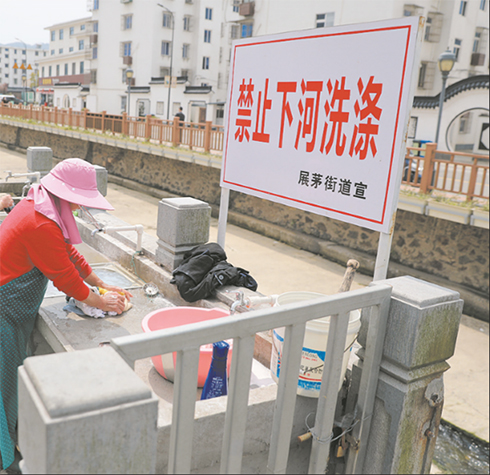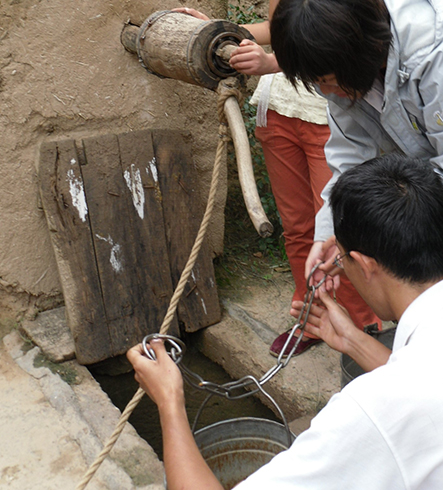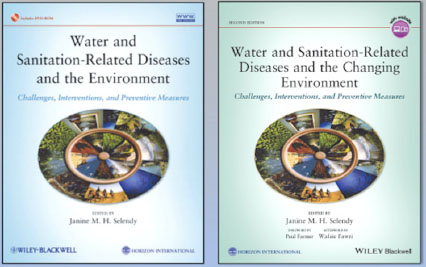Navigation
Promoting the Development of Rural Water Supply and Sanitation -Case from Zhejiang Province, China
China has made progress in improving water supply and sanitation(WSS) coverage over recent decades. The WSS services include water treatment plants and pipelines, sewer networks and wastewater treatment plants, and household service connections.
We take Zhejiang province as an example.
 Zhoushan, Zhejiang province developed the infrastructure of sewage and tap water system ...: to prevent villagers from utilizing water of the river to wash clothes. The sign reads “The sign means: Please do not wash clothes in the river.” Cited from: China Environment News(2020), https://www.cenews.com.cn/news/tp/202004/t20200401_936064.html
Zhoushan, Zhejiang province developed the infrastructure of sewage and tap water system ...: to prevent villagers from utilizing water of the river to wash clothes. The sign reads “The sign means: Please do not wash clothes in the river.” Cited from: China Environment News(2020), https://www.cenews.com.cn/news/tp/202004/t20200401_936064.html
China has made progress in improving water supply and sanitation(WSS) coverage over recent decades. The WSS services include water treatment plants and pipelines, sewer networks and wastewater treatment plants, and household service connections. Between 1990 and 2012, access to improved water supply increased from 67% to 92% and improved sanitation went from 24% to 65%[1]. However, there are still significant rural-urban disparities and a big concern to improve WSS management, particularly in rural areas. China’s rural population accounts for 50 percent of the total population. Compared to 95 percent in urban areas, only 73 percent of these rural residents have access to a piped water supply. Many rural populations still cannot receive safe drinking water service and must use surface water, shallow groundwater, and rainwater as their water sources.[2]
We take Zhejiang province as an example. Zhejiang covers an area of 105,391 square km on the east coast with total inhabitants of 54.6 million. With per capita GDP of RMB 63,266 (USD 10,273), Zhejiang is one of the more economically developed provinces in China. Even so, the geographical disparity in WSS also exits in Zhejiang[3]. The lack of water treatment and distribution facilities cause inaccessibility to safe drinking water to people in rural areas. Furthermore, coverage of sanitation services in Zhejiang varies greatly. In the lower plains, 10% to 35% of rural domestic sewage is collected and properly treated, while this rate drops to 1.7% to 5% in mountainous areas[4].

To cope with the above problems, Zhejiang Rural Water Supply and Sanitation Project(shorted as WSS project) was initiated by the Chinese Government with part of financial aid provided by the World Bank through International Bank for Reconstruction and Development (IBRD). The WSS project was approved on September 25, 2014[5]. The objectives of the Project are: 1) realizing urban-rural integrated water supply, and wastewater collection and treatment; 2) constructing and improving rural water supply and drainage facilities; 3) constructing scattered rural water supply and drainage systems in selected villages; and 4) establishing an innovative mechanism for the sustainable operation of rural water supply and drainage systems[6]. Through this project, sewer pipes were constructed that would connect all households of 500 villages to a sewerage collection and treatment network. The project has not only improved the infrastructure of water supply and sanitation in rural communities but also contributed to introducing the first rural sewage standards in China. Before then, urban sewage standards were applied to rural areas, which was inappropriate and expensive to build and operate.[7]
In the meantime, the government in Zhejiang province also proactively made efforts in improving the quality of water in the rural areas by policy and financial supports. In 2018, the General Office of the Provincial Government issued the “Action Plan for Upgrading Rural Drinking Water in Zhejiang Province (2018-2020)” (shorted as the “Action Plan”). According to the Action Plan, by 2020, 95% rural population (about 8.03million residents) are promised to access to water of qualified standards, basically achieving the same level as urban residents. By 2020, the main pipeline (from the water plants to the villages’ entrance) will be renovated for more than 12,000 kilometers, and the pipeline network within the villages will be renovated more than 29,000 kilometers.[8] To solve the problems for rural residents, it is necessary to expand the urban water supply network to the utmost extent and reduce the single water plant in the individual village: on one hand, it is important to extend the urban pipeline network and build urban water supply to county networks; on the other hand, township pipeline networks should combine and integrate to form large-scale local networks as much as possible[9].
Attention has been continuing to be assigned to the development of rural water in China. In March 3rd, 2020, the World Bank granted China a Euro 89.10 million loan (US$100 million equivalent) to improve rural water supply and sanitation services in Sichuan Province through a 25-year performance-based investment and management contract. It was the first World Bank-financed public-private partnership project in the field of water in China. According to Martin Raiser, World Bank Country Director for China, “This project will support improved water supply and sanitation services for more than 200,000 residents in rural areas in Sichuan.” [10]
It is of significance to improve accessibility to better water supply and sanitation services through global collaboration. These challenges of water supply and sanitation services affect population health, not only because of China’s large percentage of the rural population but also because its innovations and experiences will be helpful and influential for other countries. China’s renewed quest for the development of water supply and sanitation is part of a larger process worldwide.
Author: ZhangZhang
BA, Peking University
MSc, London School of Economics and Political Science, London School of Hygiene and Tropical Medicine.
[1] https://www.worldbank.org/en/news/feature/2020/03/10/access-to-sanitatio...
[3] http://jwrc-net.or.jp/aswin/en/newtap/report/NewTap_IWP06.pdf
[4] https://www.worldbank.org/en/news/feature/2020/03/10/access-to-sanitatio...
[5] http://jwrc-net.or.jp/aswin/en/newtap/report/NewTap_IWP06.pdf
[7] https://www.worldbank.org/en/news/feature/2020/03/10/access-to-sanitatio...
[8] http://www.gov.cn/xinwen/2018-12/21/content_5350794.htm
[9] https://www.shihang.org/zh/news/video/2020/03/10/china-improving-sanitat...
References:
2.http://documents.worldbank.org/curated/en/311611553534199611/China-Public-Private-Partnership-Project-for-Water-Supply-and-Sanitation-in-Sichuan-Province-Project
3.http://jwrc-net.or.jp/aswin/en/newtap/report/NewTap_IWP06.pdf
4.http://documentos.bancomundial.org/curated/es/193871468028487889/pdf/RP16330V10REVI00Box385259B00PUBLIC0.pdf
6.http://www.gov.cn/xinwen/2018-12/21/content_5350794.htm
7.https://www.shihang.org/zh/news/video/2020/03/10/china-improving-sanitation-for-better-life
9.https://www.cenews.com.cn/news/tp/202004/t20200401_936064.html
Resources:
Books, 2 Volumes: The books were written by 75 experts. Published by Wiley-Bkackell in collaboration with Horizon International. Janine M. H. Selendy (Editor)
 Books
Books
These interdisciplinary guides present the conditions responsible for water- and sanitation-related diseases, the pathogens and their biology, morbidity and mortality resulting from lack of safe water and sanitation, distribution of these diseases, and the conditions that must be met to reduce or eradicate them. They include chapters on nutrition, agriculture, population and on the connection of health and ecosystems…in a chapter entitled “Ecosystem Health as the Basis for Human Health.”
1st Volume:
Water and Sanitation Related Diseases and the Environment: Challenges, Interventions and Preventive Measures (with DVDs), and complementary material available at http://www.wiley.com/legacy/wileychi/selendy/.
2nd Volume:
The 2nd Volume Foreword by Dr Paul Farmer.
Search
Latest articles
Agriculture
- World Water Week: Healthy ecosystems essential to human health: from coronavirus to malnutrition Online session Wednesday 24 August 17:00-18:20
- World Water Week: Healthy ecosystems essential to human health: from coronavirus to malnutrition Online session Wednesday 24 August 17:00-18:20
Air Pollution
- "Water and Sanitation-Related Diseases and the Changing Environment: Challenges, Interventions, and Preventive Measures" Volume 2 Is Now Available
- Global Innovation Exchange Co-Created by Horizon International, USAID, Bill and Melinda Gates Foundation and Others
Biodiversity
- It is time for international mobilization against climate change
- World Water Week: Healthy ecosystems essential to human health: from coronavirus to malnutrition Online session Wednesday 24 August 17:00-18:20
Desertification
- World Water Week: Healthy ecosystems essential to human health: from coronavirus to malnutrition Online session Wednesday 24 August 17:00-18:20
- UN Food Systems Summit Receives Over 1,200 Ideas to Help Meet Sustainable Development Goals
Endangered Species
- Mangrove Action Project Collaborates to Restore and Preserve Mangrove Ecosystems
- Coral Research in Palau offers a “Glimmer of Hope”
Energy
- Global Innovation Exchange Co-Created by Horizon International, USAID, Bill and Melinda Gates Foundation and Others
- Wildlife Preservation in Southeast Nova Scotia
Exhibits
- Global Innovation Exchange Co-Created by Horizon International, USAID, Bill and Melinda Gates Foundation and Others
- Coral Reefs
Forests
- NASA Satellites Reveal Major Shifts in Global Freshwater Updated June 2020
- Global Innovation Exchange Co-Created by Horizon International, USAID, Bill and Melinda Gates Foundation and Others
Global Climate Change
- It is time for international mobilization against climate change
- It is time for international mobilization against climate change
Global Health
- World Water Week: Healthy ecosystems essential to human health: from coronavirus to malnutrition Online session Wednesday 24 August 17:00-18:20
- More than 400 schoolgirls, family and teachers rescued from Afghanistan by small coalition
Industry
- "Water and Sanitation-Related Diseases and the Changing Environment: Challenges, Interventions, and Preventive Measures" Volume 2 Is Now Available
- Global Innovation Exchange Co-Created by Horizon International, USAID, Bill and Melinda Gates Foundation and Others
Natural Disaster Relief
- STOP ATTACKS ON HEALTH CARE IN UKRAINE
- Global Innovation Exchange Co-Created by Horizon International, USAID, Bill and Melinda Gates Foundation and Others
News and Special Reports
- World Water Week: Healthy ecosystems essential to human health: from coronavirus to malnutrition Online session Wednesday 24 August 17:00-18:20
- STOP ATTACKS ON HEALTH CARE IN UKRAINE
Oceans, Coral Reefs
- World Water Week: Healthy ecosystems essential to human health: from coronavirus to malnutrition Online session Wednesday 24 August 17:00-18:20
- Mangrove Action Project Collaborates to Restore and Preserve Mangrove Ecosystems
Pollution
- Zakaria Ouedraogo of Burkina Faso Produces Film “Nzoue Fiyen: Water Not Drinkable”
- "Water and Sanitation-Related Diseases and the Changing Environment: Challenges, Interventions, and Preventive Measures" Volume 2 Is Now Available
Population
- "Water and Sanitation-Related Diseases and the Changing Environment: Challenges, Interventions, and Preventive Measures" Volume 2 Is Now Available
- "Water and Sanitation-Related Diseases and the Changing Environment: Challenges, Interventions, and Preventive Measures" Volume 2 Is Now Available
Public Health
- Honouring the visionary behind India’s sanitation revolution
- Honouring the visionary behind India’s sanitation revolution
Rivers
- World Water Week: Healthy ecosystems essential to human health: from coronavirus to malnutrition Online session Wednesday 24 August 17:00-18:20
- Mangrove Action Project Collaborates to Restore and Preserve Mangrove Ecosystems
Sanitation
- Honouring the visionary behind India’s sanitation revolution
- Honouring the visionary behind India’s sanitation revolution
Toxic Chemicals
- "Water and Sanitation-Related Diseases and the Changing Environment: Challenges, Interventions, and Preventive Measures" Volume 2 Is Now Available
- Actions to Prevent Polluted Drinking Water in the United States
Transportation
- "Water and Sanitation-Related Diseases and the Changing Environment: Challenges, Interventions, and Preventive Measures" Volume 2 Is Now Available
- Urbanization Provides Opportunities for Transition to a Green Economy, Says New Report
Waste Management
- Honouring the visionary behind India’s sanitation revolution
- Honouring the visionary behind India’s sanitation revolution
Water
- Honouring the visionary behind India’s sanitation revolution
- Honouring the visionary behind India’s sanitation revolution
Water and Sanitation
- Honouring the visionary behind India’s sanitation revolution
- Honouring the visionary behind India’s sanitation revolution

